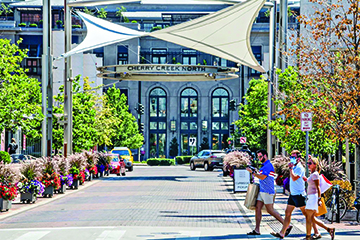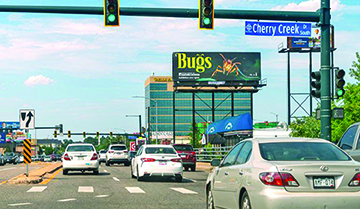Largest Creek Development In History Set To Begin; To Cut Traffic, Slash Structure Size, Use, And Heights
by Wayne New & David Steel
Wayne New is a former Denver City Councilman. David Steel is the former CEO of Western Development.

Traffic Terror: 1st Ave., University, Steele, and Cherry Creek South Drive already have terrible traffic. Cherry Creek West project will add 10,000 vehicles per day.
Have you recently driven down Alameda, University, Steele, 1st Ave., or Cherry Creek South Drive and experienced the incredible traffic and congestion in the Cherry Creek area? Have you tried to cross 1st Ave. and feared that you could be hit by a car? You are not alone.
We believe in smart, well-designed development, but we all know that the unintended consequence of too much density without concurrent transportation planning is uncontrolled traffic. However, a Denver Moves Cherry Creek statement from City Planning and the Department of Transportation & Infrastructure reads: “DMCC recommends that an increase in density in Cherry Creek is needed to support higher frequency/more reliable transit, and allow for more local trips within Cherry Creek to be taken by walking/bicycling.”
They are putting the cart before the horse!
Choking Cherry Creek
What’s driving this large increase in Cherry Creek traffic? The problem begins with the Cherry Creek North Business Improvement District’s (BID) 10-year, 150% density growth plan.
Additional causes are:

Safe Cross Streets: Major Cherry Creek North arterial streets — particularly 1st Ave. — have scarcity of safe pedestrian crossings despite shopping popularity.
- Underutilized BID underground parking and limited on-street parking is creating parking and traffic problems in the neighborhoods;
- Increased Leetsdale/Colorado cut through traffic on 1st Ave. to downtown. At least 50% of 1st. Ave. traffic is from cars originating from Leetsdale, Colorado Blvd., and University;
- Reduced RTD bus services/limited routes — limited service reduces employee transportation;
- Lack of planned transit implementation on major arterial corridors — the 2012 Cherry Creek Area Plan stated “Cherry Creek has highest regional traffic volume” and called for transit services. The City has estimated that it will take 10 to 20 years to implement transit;
- Limited use of City transportation demand management strategies to reduce traffic — City strategies to reduce traffic have not been emphasized or enforced;
- Maximum Intersection Capacities — 10 of the 13 major Cherry Creek area intersections exceed the maximum traffic of 36,000 cars per day.
Adding Obstacles
Even with all of the above, the City will be allowing the rezoning of the largest development in Cherry Creek history. This Cherry Creek West Project development on the west side of the Cherry Creek Shopping Center poses the following issues which will have to be addressed:
- Scale: The approximate 1,600,000-sq. ft. (SF) development will be 45% greater in SF compared to the present Shopping Center;
- Building Height: Three (3) of the seven (7) buildings will be 13 stories in height and one building will be 11 stories. The average height of all buildings will be 10.5 stories;
- Vehicle Traffic: According to the developer, the number of vehicle trips onto 1st Ave. and University will increase traffic by 1,000 vehicle trips per PM Peak Hour or 10,000 per day;
- Traffic Flow: The flow of traffic will be difficult with the property having only four (4) entrances/exits that are: two (2) one-way only and 2 two-way with lights. The existing Shopping Center, which is 45% smaller, has seven (7) entrances/exits with four (4) two-way with lights;
- Construction Difficulties: The entire 13-acre property will require two (2) to three (3) story-depth underground for project infrastructure construction and parking. Those 10 years of project construction will create continuous 1st Ave. traffic issues.
What To Do Now
What can immediately be done to reduce traffic, since transit is 10 to 20 years in the future?
Establish a 75% residential use ratio for new development for next five years since residential construction creates the lowest level of new vehicle trips; Expand RTD route services to Cherry Creek; Implement specific Transportation Demand Management measures for all existing and new building developments, which will have the potential of reducing Cherry Creek traffic by 2,500 vehicle trips per PM Hour:
More: a) Require RTD Eco-Pass programs to increase bus usage; b) Require hourly parking or unbundled parking for all building users, including employees; c) Implement bicycle support amenities for all buildings.
Structure Size, Height
Implement and fund shuttle services from Cherry Creek to University / I-25, the Colorado Blvd / I-25, and Colorado / I-70 light rail stations to expedite service to the present transit network.
Propose to the City a Development Impact Fee Program to help fund Cherry Creek improvements — a plan which has created millions of dollars from developers in other cities.
Even with these Cherry Creek options and recommendations, the easiest and most effective solution for immediate traffic reduction is to address new building use, size, and heights. Therefore, reducing the total CCW new development square feet and height to eight (8) stories will have a significant reduction in vehicle trips.

Crosstown Bugs: Cherry Creek Dr. South has become a major thoroughfare for drivers crossing in either direction between University Ave. and Colorado Blvd.
Resident Support
What can residents do to help? Implementation of any of these recommendations falls under the purview of the various registered neighborhood organizations (RNO) and their respective Councilperson.
Each RNO should send a Position Statement to the City & County of Denver (Councilperson). If a Position Statement is not sent, then, in effect, the RNO is endorsing the CCW Project as submitted. Written resident comments can also be sent to your Councilperson.
All concerned organizations and residents should attend Planning Board and the City Council meetings to express their opinions. Approval of the submitted CCW rezoning will create traffic and congestion for the foreseeable future. RNOs and business organizations are the ones with the stature to make a formal submittal of objection.
About The Authors
If you have questions, please contact Wayne New at wayneindenver@gmail.com or David Steel at steelyard@msn.com.
